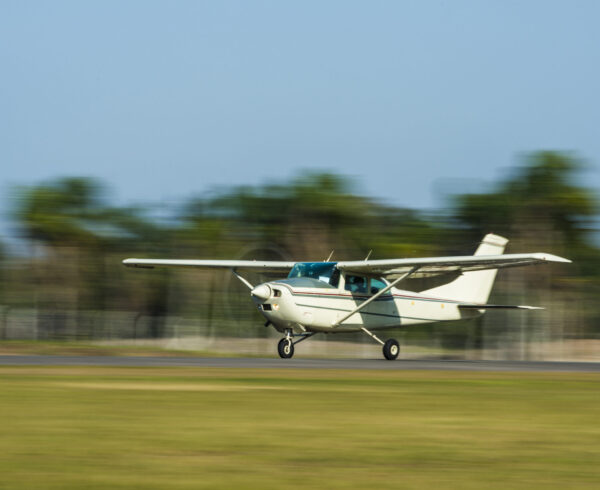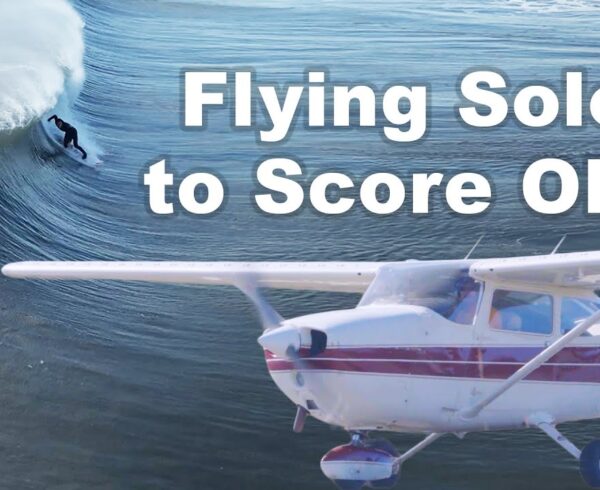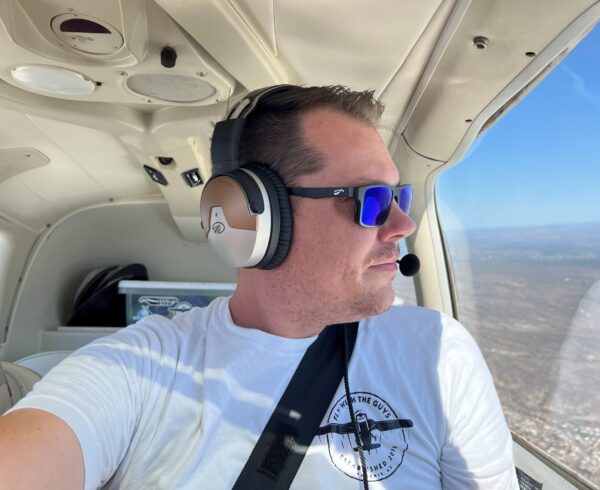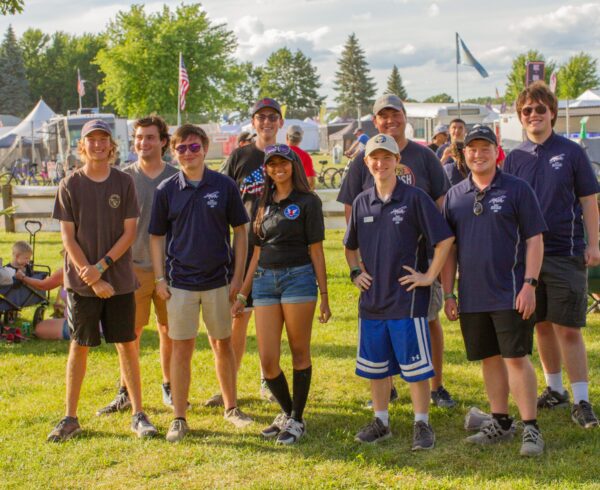“Portland Tower, Cessna 123 Delta Chili, uh, Charlie …” We’ve all had bad days on the radio. Nonetheless, clear communication in and out of the cockpit can have serious consequences.
We Have Clearance, Clarence
Radios are still not uniformly required for flight in U.S. airspace. Nonetheless, in a busy terminal environment, good radio communications are essential and poor radio habits can make everyone’s day difficult. Misunderstandings between pilots and controllers or pilots and other pilots can compromise safety and lead to aircraft incidents. Clear communication is something all pilots should treat seriously.
We all know radio communications are a critical link in the ATC system. It can be a strong bond between pilot and controller or it can be broken with surprising speed and sometimes disastrous results. Having good radios, a good audio panel, and a good ANR headset are just the beginning to clear communications with ATC. The use of proper radio technique and standard terminology and phraseology are equally essential.
What’s Our Vector, Victor?
Here’s a real story of the importance of proper comms:
Pilot: “Allegany Tower, Piper Cherokee XXXX, 8 Miles to the Left of the airport for landing…”
Tower: “Ummmm…That’s great, but not too helpful. Where are you again?”
Pilot: “6 miles now, left of the airport.”
Tower: “Let’s try that again… What’s your compass say?”
Pilot: “Oooooohhhh….Piper Cherokee XXXX, 5 Miles to the EAST of the airport for landing…Sorry”
The Aeronautical Information Manual (AIM) covers “Radio Communications Phraseology and Techniques” and most of it is common sense. It’s very useful if you’re just starting out as a pilot and it can be a good review if you are a pilot who takes the winter off. It covers the basics of radio technique, contact procedures (including the elements contained in any initial ATC contact), frequency change procedures, and proper use of aircraft call signs.
A fellow pilot writes in:
I have to admit learning to fly in Hood River, Oregon, I didn’t have a ton of towered airport experience beyond the minimums to get my ticket. I was flying in Santa Maria, CA [towered] and there was a lot of traffic. I was on the left downwind for 30. The controller told me that I needed to turn base immediately as there was a jet on long final. I was not in my airplane, but in a friend’s, so between a new N number and the direction from the controller I said “9505M Basing”. (I know…”basing”?) Someone in the tower laughed on frequency and then contacted the jet on final. The jet responded with “United 1234 Finaling for 30.” To which I said, “You guys are mean”. I still get a giggle out of basing and finaling.
The AIM also recommends that student pilots identify themselves as such on initial contact with each ATC facility. This will permit ATC to provide student pilots with extra assistance or consideration as necessary. Don’t be shy about identifying yourself as a student – ATC (and everyone else) is there to help. Example: “Dayton tower, Fleetwing one two three four, student pilot.”
Once, a student pilot landed at a controlled airport without talking to the tower and getting a clearance. He finally spoke when on ground:
Tower: Cessna XXXX, who gave you permission to land at this airport?
Pilot: My flight instructor
Tower: Well, write this number down so that I can have a chat with both of you…
Also, abbreviated call signs are ripe for misunderstanding. One of the aircraft I fly regularly was manufactured by the Naval Aircraft Factory in Philadelphia, PA. Its radio call sign is “Navy 123XYZ.” I abandoned this practice a few years ago when I was asked to keep my speed below 200 knots (that aircraft cruises at about 80). I use “Naval Aircraft Factory” now – it’s still a great conversation starter with ATC!
Roger, Roger!
Another piece of reading worthy of attention is the Pilot/Controller Glossary in the AIM. Proper radio procedures are an essential foundation to good communications. The addition of standard phraseology permits both understanding and brevity.
Some examples:
Cleared for the Option – this is ATC authorization for an aircraft to make (1) A touch-and-go, (2) A low approach, (3) A missed approach, (4) A stop-and-go, and (5) A full stop at the discretion of the pilot. Notice that this term refers to five specific types of “approach” and the pilot need not specify which one is to be used prior to execution. This clearance is obviously useful in the training environment.
Go Ahead – Proceed with your message. This is not to be used for any other purpose. It should be obvious why there should be no misunderstanding between pilot and controller with regard to the use of this term!
Negative Contact – Used by pilots to inform ATC that: (1) Previously issued traffic is not in sight, and (2) They were unable to contact ATC on a particular frequency. Here we have an example of a dual-meaning term. The meaning should be obvious from the context.
Understanding between pilot and controller is primary. Brevity of communication, particularly in a busy terminal environment, can be a very close second consideration with regard to its effect on understanding.
Nonetheless, we all have bad days and pet peeves, and ATC is not the only communication going on in the aircraft.
“Rich” was a UPT student in the Air Force learning to fly the T-37 and having a really difficult time trimming the aircraft on this particular sortie. Disgusted, the IP took the controls, trimmed the aircraft, and blurted out “There!” Rich thought the instructor was saying “There, that’s what it should look like!” The two pilots sat silently as the beautifully trimmed aircraft headed for the runway threshold as if on a rail. Unfortunately, what the instructor meant was “There, I trimmed it for you, take it back!” So the aircraft continued pilotless to the threshold, where it hit nosewheel first and entered the mother of all PIOs.
Fortunately, the only thing damaged that day was a pair of egos.
But it’s not always those flying. Here’s one from the Tower Frequency during a VFR arrival at AirVenture a few years ago:
Tower: “Red taildragger, you’re my guy! You’re leading the next group, so I’ll call your turn to final and the rest will follow you. Ok. Red Taildragger, turn now! Ok…now! Red taildragger, turn onto final please, everyone else, follow… Ummm…ok, maybe you’re not coming to the show after all. BLUE HIGH WING… You’re my guy!”
And sometimes, we just misspeak with hilarious results. A friend wrote in to say:
I was flying in to South Lake Tahoe airport for a conference. I was descending over the lake and made the following position call, “Lake Taco area traffic red and white Mooney descending over the lake, inbound.” That’s right Lake Taco. I was mortified and the butt of many jokes at the dinner that night.
Fly safe and make yourself understood! This short video is the gold standard for in-cockpit miscommunication.
Be sure to share your favorite stories like these in the comments below.















I regularly fly into an airport in the southwest where there is a very large contingent of student pilots in the air, many of them foreign students going through primary training at the flight schools on the field. Unfortunately, many of them are learning English at the same time, which leads to a great deal of misunderstanding and subsequent clarification over the tower frequencies. This was actually overheard recently when a student pilot was returning to the field after a session in the practice area and the controller was asking the student to confirm he had received the field ATIS: Tower – Mesquite 123, confirm you have Hotel. Student – negative, I have student housing.
For Anna: Neither are radios mandatory in all European airspace. The EASA Air Ops regulation for NCO clearly states that radio is only required by airspace regulations. So I think you will find that in general except if in a RMZ you are, during daytime, perfectly legal not to be radio equipped in E (as long as VFR) and G airspace. The requirements are for communication, not equipment.
Due to the Corona the seminar I was going to give on communications at the local airport was cancelled. My seminar was very simular to your article. Thanks for putting this out to the public.
Unlike an earlier comment I found this blog bth funny and educational. Whilst I did not learn anything new it is good to be reminded of how important clear communication is, and the importance of using standard phraseology.
That was particularly evident in the Airforce. anecdote where the instructor said “there” rather than “handing over”.
As a pilot flying in Europe I was stunned by this sentence in your article: “Radios are still not uniformly required for flight in U.S. airspace. ”… how can that be in the year 2020? – why wouldn’t this basic tool be mandated?
Dear Anna,
If you can, please have a look at a VFR map of the open spaces in the Western US. Yes, if we want we can fly completely free … after paying for avgas and other items. Most of us are quite good over the radio, though.
Tailwinds,
Glenn Swiatek
N51RV
Anna, it is unfortunately true. There are many of us flying here in the US that wonder the exact same thing.
Loved the article guys! I think real-life examples help to further exemplify what you wanted to point out in the story. I have an airport near me called RWI (Rocky Mount Wilson). I’ve called it Romeo Wilson India a few times and it always causes confusion with ATC 🙄 (Air Traffic Control)
Because we Americans talk so loudly we hear each other without the help of a radio!
because there is a Whole Lot of Open space to fly, Much more than there are congested places to fly and there realy is no need for a radio.
Anna,
We in the USA have lots of controlled airspace that require communication, ADS-B etc. But we also have lots of very rural areas in our country that have airports with little activity. If proper procedures are followed it is very safe to fly without comm in those areas. Also, there are hundreds of private airports where the sole aircraft is that of the owner.
I hope you have the opportunity to come here and experience the freedom to fly with less regulation. It is amazing.
(That said, I personally always use a radio and the vast majority of us do – we just appreciate the fact that we done HAVE to. If you get ready to take off on a VFR local or short trip flight, it is nice to know you can safely conduct the flight NORAD.)
Stephen
Hi Anna, thank you for your feedback! Indeed, the difference in aviation law between Europe and the US is always an interesting topic. I can certainly explain US aviation law as it exists, but explaining the absence of law is a little more difficult. My answer depends on whether you are asking about mandating the possession of a radio or the *use* of a radio.
The US is a large country with very low population density in many places (consider Alaska). It makes no sense to mandate communications and ATC control in these areas. So mandating the USE of a radio does not make much sense (nor is it feasible in terms of ATC staffing, etc).
As for mandating the *possession* of a radio, that is another matter. I agree with you, having a radio (and a backup handheld) is just good common sense. However, this is a choice left to the aircraft operator. Required equipment for basic VFR flight is fairly minimal – start with 14 CFR 91.205 and you’ll see. We are rugged individualists.
Along the lines of safety, pilots rarely consider other potential uses for the radio (and handheld) in an emergency. Many of the remote areas in the US still lack adequate cell phone coverage. If you were to go down in one of these places, a radio would be VERY useful in potentially calling other aircraft for help, for example.
With regard to the relationship between law and safety, I quote my very first flight instructor: “What’s safe isn’t always legal and what’s legal isn’t always safe.”
Fly safe!
1. How about specifying WHERE to find “Radio Communications Phraseology and Techniques” in the AIM. I realize it should be burned into my memory, but somehow it’s not.
2. I thought this message was going to talk about the RIGHT way to communicate with the tower, and “ATC”. Instead, it’s just a couple of war stories. Entertaining, but not very helpful to a low time pilot.
3. Although I’m not a student anymore, I still identify myself as “low time pilot” on first contact, hoping for more patience and clarity from the tower. Like to get some opinions about that.
Thanks
UPT- Undergraduate Pilot Training. The Air Force’s name for basic pilot training. After completing this training, generally about a year long, Air Force pilots get their wings. They still are not useful for much until they go to advanced pilot training in their specific-assigned aircraft.
IP – Instructor PIlot – The Air Force’s term for what civilians would call a CFI – Certified Flight Instructor.
Regarding “where to find correct phraseology” Start with Chapter 4, Section 2 of the AIM. If you are an AOPA member, try this as well – https://www.aopa.org/training-and-safety/students/presolo/special/new-pilots-guide-to-atc-communication
Best wishes and happy flying to you both
Hi John,
I’m sorry that you felt this piece missed the mark. First off, to answer your question: you want to pay specific attention to Chapter 4, Section 2 of the AIM. The other big resource is the Pilot/Controller Glossary in the very back of the AIM (after Appendix 3).
I should explain that as we publish fresh content on our blog, we strive to walk a balance between entertainment and information. Sincere thanks for the feedback!
While on the topic of clear communications; UPT, IP and PIO?
Being a fairly new pilot, the use of acronyms and abbreviations often seems like a joke being played on newbies by the old boys club. It has become my personal axe to grind.
Wikipedia has a more extensive alphabetical index of aviation, aerospace and aeronautical abbreviations than NavCan (s#!t! there’s another one!) Wiki (another?) lists more than 100 entries under “A” alone. Among these, there are three definitions for “ACC”, no definition for either “UPT” or “IP” and “PIO” is defined as a “pilot induced oscillation”; is this what you meant?
WTF? (there it goes again!)
(Don’t take all this too seriously – I love your newsletter and my Lightspeed headset.)
Hi Dan, thanks for the feedback. I’m sorry you feel overwhelmed, hang in there! You’re drinking from the firehouse right now in terms of the material being thrown at you. There is a lot to learn in the aviation world. Believe it or not, the acronyms seemed worse when I was a young pilot.
In the spirit of making you smile on a Monday, let me tell you about airspace alone when I was a student pilot:
Class A was the Positive Control Area (PCA)
Class B was a Terminal Control Area (TCA)
Class C was an Airport Radar Service Area (ARSA)
(There were also these things called TRSAs which were optional ARSAs)
Class D was an Aiport Traffic Area (ATA)
There were these things called “Control Zones” (CZs) which got lumped with “controlled airspace” to become Class E.
Class G was just “uncontrolled airspace”
Now, isn’t Class A, B, C, D… a little more palatable?
Don’t get me started on what “controlled” meant! 🙂
Hang in there, you’ve got good company!
any traffic in the area please advise……NOT!!
Thanks for the articles, good reminders!
We used to get in plenty of trouble from the tower at East Texas Regional when I was a student at LeTourneau University. All our N numbers ended in LU. Just to spice things up a little, we’d replace Lima Uniform with something like, “… cleared for the option, N32-Llama-Unicorn…”
Good times for us, not so much for ATC 🙂
We have a Localizer Final Approach Fix named “STAIN.” One time an inbound IFR flight was not doing all that well and both Approach and the Tower were concerned about the pilot’s ability. When Approach handed the pilot off to the Tower, the Tower asked the pilot to “Report STAIN.” The pilot responded with, “We’re stayin overnight!”
My Canadian registration is CGOMU, abbreviated to Oscar Mike Uniform. I’m sure I’ve called myself Oscar Mike Unicorn on more than one occasion.
US controllers often get tangled up in Canadian call signs. I regularly get called Zero Mike Uniform. Rather than point it out, as long as clarity is assured, I will accept the call but reply with (Charlie Golf) Oscar Mike Uniform. (I try extra hard not to introduce a unicorn into the mix.)